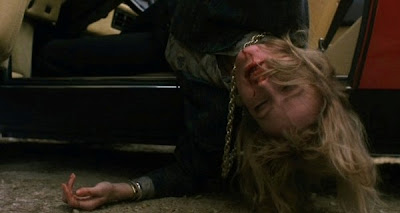 A cynical person will probably approach this stunning masterwork and declare it to be the primary reason as to why no other romantic comedies about bickering psychics in South America were made after it quickly came and went from theatres back in 1988. However, a deeply rational person with a sensible sense of self and the ability to appreciate fingerless gloves from afar will no doubt see a film that is literally oozing with the correct kind of moxie. Now, I'm not saying that I'm one of these so-called "sane people." (I am totally objective and base my opinions on the linear teachings of Rhonda Shear.) But even the dullest spoon in the tool shed can clearly see that the kinetic Vibes is conspiring on a completely different level when it comes to handing out the nonsensical charm. Making a competently made film, one that intelligent humans slobber over like an orgasm-inducing virus, is quite easy. On the other hand, making a film that always seems a tad off is extremely difficult. And that's how I would categorize this Ken Kwapis directed psychic adventure. I mean, there's definitely something wrong going on here. Yet, it's this wrongness that makes the film such a bizarre pleasure to roll around in.
A cynical person will probably approach this stunning masterwork and declare it to be the primary reason as to why no other romantic comedies about bickering psychics in South America were made after it quickly came and went from theatres back in 1988. However, a deeply rational person with a sensible sense of self and the ability to appreciate fingerless gloves from afar will no doubt see a film that is literally oozing with the correct kind of moxie. Now, I'm not saying that I'm one of these so-called "sane people." (I am totally objective and base my opinions on the linear teachings of Rhonda Shear.) But even the dullest spoon in the tool shed can clearly see that the kinetic Vibes is conspiring on a completely different level when it comes to handing out the nonsensical charm. Making a competently made film, one that intelligent humans slobber over like an orgasm-inducing virus, is quite easy. On the other hand, making a film that always seems a tad off is extremely difficult. And that's how I would categorize this Ken Kwapis directed psychic adventure. I mean, there's definitely something wrong going on here. Yet, it's this wrongness that makes the film such a bizarre pleasure to roll around in. A kooky mix between The Treasure of Sierra Madre, The Holy Mountain and any movie where a man and woman initially dislike each other but gradually learn to endure one another's quirks, the beautifully photographed endeavour is a flighty throwback to the adventure films of the 1930s. It's true, I haven't seen any of those films from the 30s, but I'm gonna pretend I have, you know, just for the sake of my point.
A kooky mix between The Treasure of Sierra Madre, The Holy Mountain and any movie where a man and woman initially dislike each other but gradually learn to endure one another's quirks, the beautifully photographed endeavour is a flighty throwback to the adventure films of the 1930s. It's true, I haven't seen any of those films from the 30s, but I'm gonna pretend I have, you know, just for the sake of my point. Anyway, unlike those particular adventure films, the imperialist scum who want to plunder the indigenous people of their natural riches are a tad more discreet in their plundering. Actually, when you think about it, they're not discreet at all. Nevertheless, the fact the filmmakers got permission to film in Ecuador really enhances the proceedings. This gave the film an inexplicable authenticity. Which is weird, especially when you consider how stupid it is at times.
Anyway, unlike those particular adventure films, the imperialist scum who want to plunder the indigenous people of their natural riches are a tad more discreet in their plundering. Actually, when you think about it, they're not discreet at all. Nevertheless, the fact the filmmakers got permission to film in Ecuador really enhances the proceedings. This gave the film an inexplicable authenticity. Which is weird, especially when you consider how stupid it is at times. The casting two of the strangest... okay, three of the strangest – Peter Falk ain't exactly perpendicular and junk, isn't necessarily the wisest course of action when setting about producing a romantic buddy movie about clairvoyant New Yorkers scouring the mossy mountains of Ecuador. That being said, I couldn't imagine this film without Cyndi Lauper and Jeff Goldblum as the duped psychics who are forced to help greedy treasure hunters find a shitload gold at the location of some lost Incan city.
The casting two of the strangest... okay, three of the strangest – Peter Falk ain't exactly perpendicular and junk, isn't necessarily the wisest course of action when setting about producing a romantic buddy movie about clairvoyant New Yorkers scouring the mossy mountains of Ecuador. That being said, I couldn't imagine this film without Cyndi Lauper and Jeff Goldblum as the duped psychics who are forced to help greedy treasure hunters find a shitload gold at the location of some lost Incan city. The sight of the impish Cyndi as Sylvia Pickel, an astral projectionist with an invisible friend named Louise, and the lanky Mr. Goldblum as Nick Deezy, a second-sighted museum curator who can tell where an object has been just by touching it, wandering around Ecuador together is something you couldn't possibly concoct unless you were totally high. Without their cockamamie chemistry, I think Vibes would have probably expired tonally before it even got around to making the journey to the south.
The sight of the impish Cyndi as Sylvia Pickel, an astral projectionist with an invisible friend named Louise, and the lanky Mr. Goldblum as Nick Deezy, a second-sighted museum curator who can tell where an object has been just by touching it, wandering around Ecuador together is something you couldn't possibly concoct unless you were totally high. Without their cockamamie chemistry, I think Vibes would have probably expired tonally before it even got around to making the journey to the south. Sure, the brief appearance of Jennifer Balgobin (Dr. Caligari) and Steve Buscemi (Ghost World) at a New York raceway, the even briefer turn by Max Perlich (Homicide: Life on the Street) as a busboy, and the sultry work of the gorgeous Elizabeth Peña (Lone Star) as a femme fatal in uncomplicated lingerie might have sustained the film from falling completely off track for a little while. But come on, who are we kidding here? The film is only barely on the cusp of being bearable because of what Cyndi and Jeff brought to the psychic table.
Sure, the brief appearance of Jennifer Balgobin (Dr. Caligari) and Steve Buscemi (Ghost World) at a New York raceway, the even briefer turn by Max Perlich (Homicide: Life on the Street) as a busboy, and the sultry work of the gorgeous Elizabeth Peña (Lone Star) as a femme fatal in uncomplicated lingerie might have sustained the film from falling completely off track for a little while. But come on, who are we kidding here? The film is only barely on the cusp of being bearable because of what Cyndi and Jeff brought to the psychic table. My favourite scene between the two was when Cyndi compliments Jeff's legs in the tent. The way Jeff struggled to return the compliment was factually adorable. I mean, I, too, would struggle to praise Cyndi's shapely, underrated legs if I was in such close proximity to them.
My favourite scene between the two was when Cyndi compliments Jeff's legs in the tent. The way Jeff struggled to return the compliment was factually adorable. I mean, I, too, would struggle to praise Cyndi's shapely, underrated legs if I was in such close proximity to them. Delightfully oddball to outer reaches of tolerableness, Cyndi Lauper simultaneously channels the hard-nosed gumption of a street hustler, the Queens-reared surliness of an overworked tollbooth attendant, and the vixenish glee of a re-animated Jean Harlow. Listening to her enunciate words in Vibes was like eavesdropping on what heaven, or some heaven-like facsimile, must sound like when it's at its most loud and grating. Gentling caressing my auricle area is one thing, causing my eyes to wet themselves is quite another.
Delightfully oddball to outer reaches of tolerableness, Cyndi Lauper simultaneously channels the hard-nosed gumption of a street hustler, the Queens-reared surliness of an overworked tollbooth attendant, and the vixenish glee of a re-animated Jean Harlow. Listening to her enunciate words in Vibes was like eavesdropping on what heaven, or some heaven-like facsimile, must sound like when it's at its most loud and grating. Gentling caressing my auricle area is one thing, causing my eyes to wet themselves is quite another. The many different outfits Cyndi sports in this movie were a flat out assault on my cerebral cortex. No wonder the elemental plot was so hard to follow. Whether she was summoning dead relatives in glimmering nightclothes, eating fries in a blue backless cocktail dress, or being dipped on the dance-floor in one of her many pink ensembles, Cyndi brought an uniquely sexy aura to all her looks. It got to a point where the anticipation over what she'd wear next would consume the marrow of my very existence.
The many different outfits Cyndi sports in this movie were a flat out assault on my cerebral cortex. No wonder the elemental plot was so hard to follow. Whether she was summoning dead relatives in glimmering nightclothes, eating fries in a blue backless cocktail dress, or being dipped on the dance-floor in one of her many pink ensembles, Cyndi brought an uniquely sexy aura to all her looks. It got to a point where the anticipation over what she'd wear next would consume the marrow of my very existence. The collaboration between Cyndi and costume designer Ruth Myers must have been explosive in terms of creative cohesion. Though, I have to say, I did doubt their couture-based cohesiveness when it came time to shift the action from New York to Ecuador. I thought: "Oh, great, say goodbye to the magenta, and say hello to bland hiking clothes." But all my fear was for naught, as her wacky style remained pretty much the same in both locals. Which has to be a testament to something; it's just gotta.
The collaboration between Cyndi and costume designer Ruth Myers must have been explosive in terms of creative cohesion. Though, I have to say, I did doubt their couture-based cohesiveness when it came time to shift the action from New York to Ecuador. I thought: "Oh, great, say goodbye to the magenta, and say hello to bland hiking clothes." But all my fear was for naught, as her wacky style remained pretty much the same in both locals. Which has to be a testament to something; it's just gotta.video uploaded by amy5cents
...



































































































